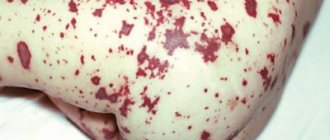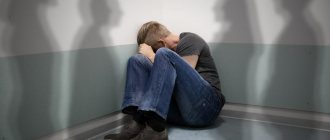Schizophrenia in children is an extremely rare phenomenon.
It usually “blooms” during adolescence. In psychiatry, childhood schizophrenia is a disease that manifests itself before the age of 12. The disorder in children is characterized by some specificity of symptoms and difficulty in diagnosis. The vigilance of parents and a qualified specialist will help to recognize the disease in time and begin timely therapy.
What causes the disorder
It is immediately worth noting that the exact, final cause of childhood schizophrenia has not yet been clarified, and the probable ones can be defined as combined. Both biological and social factors play a role here.
Among the biological predisposing factors, primarily genetics and heredity are distinguished. It has been established that the majority of children suffering from the disorder have sick relatives, either immediate or even secondary.
Biological causes also include damage to the central nervous system. Damage to brain structure plays an important role in the manifestation of the disorder. They are divided into perinatal and postnatal.
Perinatal risk factors are defects acquired in the womb. They can develop due to:
- intrauterine fetal hypoxia;
- intrauterine infections;
- placental abruption;
- lack of nutrition;
- toxic effects on the fetus - maternal abuse of alcohol and drugs during pregnancy; taking medications prohibited for pregnant women; if the pregnant woman has been exposed to toxic substances.
Postnatal risk factors include those that affect the child after birth. Traumatic brain injuries play a special role here. This group also includes neuroinfections, that is, infections that destroy brain tissue: encephalitis, meningitis, neurosyphilis. Conditions that cause brain hypoxia predispose to the development of the disease.
But all these reasons may be powerless if the child is surrounded by a prosperous social environment.
The risk appears if a child grows up and is brought up in an unfriendly, oppressive atmosphere. This concerns the violence to which the child is subjected: beatings, aggression from parents, systematic accusations, inadequate assessment of actions. Child abuse often occurs in families where parents are drug addicts or alcohol abusers.
Another model of behavior is when parents raise their child with excessive severity, make excessive demands on him, dictate their preferences, and establish increased control. That is, education from the cycle: “a step to the left, a step to the right - execution.”
In another family, the child seems to live and be raised according to the rules, but the relationship between the parents does not work out. Constant quarrels, scandals, misunderstandings between spouses leave a negative imprint on the child’s psyche, especially if he witnesses violence.
But it also happens that the family is quite prosperous, the relationships between its members are positive and friendly, but the baby was exposed to a severe stress factor. This could be the death of a loved one, violence, or a child witnessing a terrible event. In this case, there is also a risk of manifestation of the disorder.
Recommendations
In order to prevent the occurrence of schizophrenic disorder in children and adolescents, parents should take the following measures:
- undergo regular examinations with a psychologist and psychotherapist, especially if their child belongs to a risk group for the occurrence of pathology;
- pay attention to all personal changes, especially during adolescence;
- it is necessary to conduct conversations about the dangers of alcohol and drugs;
- children should feel the support of loved ones in developing social skills and forming positive relationships between members of society;
- It is important to maintain a healthy psychological and mental atmosphere in the family and not use moral and physical violence.
Experts advise parents and the surrounding society to adhere to certain rules for raising and communicating with schizotypal individuals.
- Protect them from stressful situations; communication should be explanatory, not commanding, in tone.
- Too early psychological stress in the form of learning foreign languages, mathematics, etc. leads to a deterioration in the general condition.
- Showing the maximum possible amount of attention and patience to the patient.
- Communication with a schizophrenic should be as respectful as possible, without any pressure or ridicule.
- Physical therapy shows good results.
Schizophrenic disorder is a serious illness that can ruin the life of a still mentally fragile child. Therefore, parents should be as attentive as possible to their children, and remember one thing: the sooner the symptoms of the disease are identified, the sooner treatment can begin. This, in turn, significantly increases the chances that such a person will be able to lead an active, fulfilling life in the future.
Early childhood schizophrenia
Symptoms and signs of childhood schizophrenia have many similarities with its course in adults. But, nevertheless, they are not without specific manifestations, which, it must be said, complicate its diagnosis.
The disease is divided into three types, covering different age periods:
- schizophrenia of early age – from 0 to 3 years;
- preschool age - from 3 to 5–7 years;
- school age - after 7 years;
Surprisingly, the first signs of schizophrenia in children can be noticed already in infancy, in the first year of life, although during this period they appear quite rarely. The difficulty is this: they are so vague and atypical that not every mother can suspect the onset of a mental disorder in them:
- the child is lethargic and inactive. Doesn't respond to toys. Doesn't wake up for feeding, doesn't cry before feeding. It seems that he does not feel hungry. Shows emotional coldness towards the mother: does not smile at her, does not reach out to her. Indifferent to uncomfortable conditions;
- motor excitation. Occurs during the daytime. The child lies in the crib and jerks his arms and legs. But these movements are not similar to normal age-related motor activity. They are monotonous, reminiscent of automatisms. They occur against a reduced emotional background, that is, the baby does not show any emotions. Motor skills do not become more difficult with age. Moreover, those already acquired are lost;
- affective disorders. Excessive tearfulness appears. The baby cries both day and night. Anxiety and crying occur in periods, alternating with phases of relative calm. For example, anxiety attacks can be repeated 2-3 times during the night.
Symptoms of schizophrenia in children of the second or third year of life are accompanied, first of all, by the extinction of emotions. Children become inactive, unsmiling, and unemotional. In some cases, children who have already begun to walk lose this ability. They begin to crawl, their movements acquire a chaotic direction, developmentally corresponding to one month of age.
On the other hand, such kids become excited. They are often in a state of constant, aimless walking, in a circle or in the form of a pendulum, swaying from side to side. At the same time, the face becomes detached or the children begin to make different grimaces. Despite walking for a long time (1 hour or more), they do not get tired. It becomes very difficult to stop them from aimless desires. They break free and continue the process.
Disorder at this age can also be expressed in unreasonable laughter or crying, in disorganized running and jumping.
Sharp excitement gives way to lethargy. Children tend to lie down in a quiet, distant place: under the bed, in the corner. They take an unnatural pose. It is very difficult to take them out for a walk; you have to do it by force. Sleep is also disturbed. Kids wake up in the middle of the night and spend a long time without sleep.
In general, the picture of the disease in children under 3 years of age comes down to aimless movements and automatisms, and regression in development. Against the background of a pathological condition, fears arise that have no basis. This could be a fear of any object: cars, trees, etc. When a frightening object comes into view, the child becomes anxious and excited. But once you remove it from sight, the baby’s condition returns to normal.
Causes
Experts are unanimous about the reasons that can trigger the onset of the schizophrenic process in adolescence, calling them multifactorial. They are limited not only to age-related changes, when the crisis of adolescence occurs.
The disease, depending on the speed of its progression, can take different forms. For some, the immersion in the endogenous disease of the schizophrenia spectrum is deeper, and requires serious medical inpatient treatment. For others, the symptoms weaken as much as possible after therapy, and they are able to continue to carry out full-fledged active social activities.
According to one of the scientists’ hypotheses, all causes of mental pathology are conventionally divided into three types:
- genetic. The risk of schizophrenia increases significantly in the category of adolescents whose relatives have had this pathology. Heredity is aggravated by severe stress, other serious mental health illness or family environment;
- biological. Adolescence is characterized by changes that occur in brain structures. Some neural connections disappear over time, and others, more stable and durable, are formed in their place. Some individuals with particularly unstable psyches may have an inability to independently cope with strong feelings or tense situations;
- psychoanalytic. Those children who unconsciously perceive themselves as part of the mother's body are more prone to developing a mental disorder of a schizophrenic nature. Such emotional attachment leads to the fact that the younger generation is not able to independently endure a traumatic situation that has not yet developed the psyche, suggesting possible separation from their parents - an exam at an educational institution, divorce, the death of a loved one.
The most common causes of the disease are severe emotional shocks, alcohol abuse, taking narcotic and other potent drugs, infectious and inflammatory processes in the brain, and head injuries.
Schizophrenia in preschool children
In children aged 3 to 7 years, the disease begins with emotional coldness. Children become indifferent to what is happening, limit communication with peers, and do not show warm feelings towards their parents. Previously acquired knowledge and skills are lost, interest in favorite activities and toys disappears.
Little patients become capricious, and their mood undergoes sudden changes and fluctuates over a wide range.
Children do not show interest in their appearance and refuse to perform daily hygiene procedures. They become sloppy, may wear dirty clothes, and go to sleep on the floor.
Behavior also changes. In their actions they can display the manners of younger children. For example, a child who was already quite fluent in using a spoon and fork, suddenly begins to eat with his hands, scatters food, and crumbles it.
He spends almost all his time alone, fencing himself off from people. It is difficult to tolerate innovations in his regime. His games become primitive, losing their plot. They come down to feeling objects and toys, sniffing them. The theme of the game does not matter - such children are attracted only to individual actions. In other words, games take on a stereotypical character: a preschool child opens and closes the closet door, arranges objects in a certain sequence. If his work is interrupted, he becomes very angry.
The disorder has a particular impact on speech. So, if the child has already expressed his thoughts well and competently, then at the beginning of the illness one can note a violation of the semantic arrangement of words in a sentence. Gradually, speech becomes incoherent, the child is unable to clearly express his thoughts. Echolalia appears - repetition of words spoken by someone. Little by little, a full-fledged, intelligible narrative becomes incoherent and incomprehensible. Sentences are shortened, words are replaced with syllables. Soon the speech turns into incoherent babble.
As the process progresses, children show signs of catatonia. They are inhibited, frozen in one position. For example, they sit bent over and throw their head back, or lie in a fetal position. At the same time, the look is absent, they do not make contact.
The other side of catatonia is elevated mood, agitated behavior. The child jumps, laughs, fools around for no reason.
Productive symptoms of childhood schizophrenia
Schizophrenia in preschool children manifests itself in the form of pathological fantasizing. What distinguishes it from typical children's fantasies is the unreality and persistence of the imaginary. Painful fantasies are pretentious in their themes, and are accompanied by changes in behavior.
The child is reincarnated into some object and is able to remain in his new role for several days. For example, a boy, seeing himself as a car, twisted his arms and moved his legs, imitating its driving. I stopped periodically to refuel as I was running out of gas. Everyday needs were carried out automatically, and then under the pressure of adults.
Fantasies in the form of fairy-tale creatures, monsters, and dragons are common.
Productive symptoms in preschoolers are also represented by delusions and hallucinations. But they are less pronounced than in school-age children and adults.
Hallucinations can be visual, auditory, or oral in nature. Visual hallucinations usually appear at the moment of falling asleep or waking up. The child develops a feeling of fear and anxiety. He peers into the room, directs his gaze to a certain part of the room. He says there is a blue wolf standing there, there are a lot of spiders on the ceiling, or a snake is crawling on the bed. He sees a glowing face and a black paw.
Auditory hallucinations in young children rarely involve voices in the head. More often they “come” in the form of a rooster’s crow, the striking of a clock, someone’s crying, the voice of evil forces: a witch, an evil sorcerer, villains from cartoons.
Oral quirks include sensations such as a burning sensation in the mouth, the presence of an object, hair, or crumbs.
Among delusional ideas, the delusion of persecution comes to the fore.
School age schizophrenia
Starting from the age of 6–7 years, the child spends most of his time at school. Therefore, the onset of the disease can be determined by the nature of the educational activity. Such children are noticeably behind in mastering educational material compared to their peers. All their cognitive functions suffer, their voluntary attention is poorly developed, that is, it is very difficult to keep it focused on the material being taught. But involuntary attention in such children, on the contrary, is more pronounced.
The problem of perception lies in understanding the integrity of the picture. It is difficult for a child to grasp the general meaning. He breaks down what he says or sees into separate parts. Memory is selective. Only that which sincerely interests the sick child is remembered. It is almost impossible to force him to learn educational material if he does not want to.
Such children drop out of the life of the team. They remain aloof and withdraw into their own world. They develop strange passions and hobbies. They are characterized by fragmented thinking, reasoning, and separation from reality. Their thoughts take on a dark and frightening character. Children are suspicious, look for a trick in everything, and may assume that everyone is watching them. Gradually they become autistic, separate from the world around them, and withdraw into themselves.
Abulia develops - lack of will. It is difficult for a child to persuade himself to engage in activities, although he understands the need for this. He spends most of his time in bed, refuses to go to school, and does not communicate with friends.
As the disease progresses, delusions and hallucinations join the symptoms. The latter appear in the form of voices that frighten and incline to a certain action. Often children are silent about their appearance.
Gradually, the disease takes on one of its forms. Childhood schizophrenia manifests itself in the following forms:
- sluggish – the most common form of the disorder. Its early sign can be superpowers in any area - drawing, mathematics, music. But over time they are lost. Children suffering from this form of the disease are characterized by pathological fantasies, obsessive fears, and fanciful hobbies;
- paroxysmal - progressive - the symptoms of the disease are not clearly expressed. And it manifests itself in periods. But it leads to irreversible consequences like schizophrenia;
- paranoid – occurs less frequently than other forms. Among its symptoms are delusions of persecution, poisoning, malignant fantasies and fears. Expressed emotional coldness;
- hebephrenic – excited, aggressive behavior. Characteristic are antics, grimacing, pretentiousness;
- catatonic - taking pretentious poses and freezing in them or increased impulsiveness and excitability in actions. Meaningless speech, imitating movements, words of other people.
Diagnostics
A psychiatrist who works with childhood mental disorders can make a diagnosis of childhood schizophrenia. The complexity of the diagnostic process is the difficulty of differentiating delusional thinking from typical childhood fantasy. Eccentricity, social isolation, hallucinations are symptoms not only of schizophrenia, but also of many other pathologies.
Collecting anamnesis and family medical history is an important stage of diagnosis. But it is impossible to say about the presence of schizophrenia just by a set of symptoms. Modern diagnostic methods include neurotesting. This is taking a small sample of blood from your finger. Next, the sample is analyzed - in schizophrenia, there is a noticeable increase in the studied substances.
During the diagnostic process, it is necessary to conduct a pathopsychological study. It is important to carefully examine the child's cognitive processes. Disturbances in the thought process are noticeable in the presence of certain deviations during pathopsychological diagnosis.
An accurate diagnosis can only be established after long-term observation of the child. It is also important to differentiate schizophrenia from other pathologies:
- differences from mental retardation are noticeable after EEG, MRI;
- with convulsive syndrome, loss of consciousness is observed, but with schizophrenia - not;
- Unlike neuroses - with schizophrenia, emotional coldness, pretentious behavior and speech are expressed.
It is especially difficult to diagnose pathology in infancy. The reason is the underdevelopment of speech, communication abilities, and the similarity of symptoms with other disorders. In infants, attention is paid to a sudden change in motor activity - a previously lethargic baby begins to crawl abruptly and try to get to his feet. At the same time, it is impossible to calm the child. A clear sign is also a change in emotional reactions to the mother - the child ceases to rejoice at her appearance or does not distinguish the mother from other women. In infants with schizophrenia, previously acquired abilities are lost and they regress.











